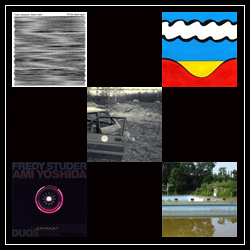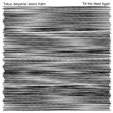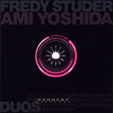|
|
 |

|
 |
Dusted Features
This Swiss label, specializing mostly in electroacoustic improvisation, has been on a roll of late. Jason Bivins checks in with the label's recent activities, surveying the latest five releases.
|
|
|
 |
Five For4Ears
It’s been a busy season for Günter Müller’s For4Ears imprint, one of the finest outlets for electro-acoustic music going. In this series of mostly excellent recordings, the label’s well-earned reputation is confirmed.

Wireless-Within (For4Ears 1655) is another document of an already well-known season of musical encounters in Australia. In July of 2002, Müller and the legendary, now defunct duo Voice Crack (Norbert Möslang and Andy Guhl on cracked-everyday electronics) traveled to South Australia for some festival dates. There they recorded the outstanding Oystered (with Oren Ambarchi, on Audiosphere), while Müller and Ambarchi created Strange Love (For4Ears 1448) with Melbourne-based sound artist Philip Samartzis. From this rich moment, we have the present document of three lengthy improvisations featuring Müller, Voice Crack, and Samartzis, and the results are extremely good. Samartzis, who ought to receive far more attention than he does, creates many of this music’s most unexpected moments. Müller and Voice Crack always play well together and, for such a long-standing association, have an impressively varied record. But Samartzis’ tapes and reconstructed sound atmospheres (many of which were inspired by a visit to a South Australian rainforest) provide fascinating curve balls – the sound of flies buzzing, a great “sproing!” or a guttural incantation – which contrast masterfully with the Europeans’ lush beds. At times the proceedings are far more raucous than listeners have come to expect from this music (listen to the fascinating laser wars at the end of “tombac_toothless”), but in general the music is extremely subtle and well paced, as on “Baccus_Marsh.” Here, slow rustles and occasional moans are tastefully deployed in its opening minutes, only grudgingly allowing improv dialogue to commence. But when it does there’s a lovely and unexpected fractiousness, as if machines were erupting through the earth in some night forest, with bamboo groaning under the strain and nightbirds crying in panic. Just as suddenly, the piece crackles its way into a recording of children’s voice, calling impatiently to each other. And the record closes with the lovely descending drone which begins “bleep_black,” riding out from there on a conjunction of sine tones, more voice recordings, and an ominous low moan.

Unpredictable guitarist Tetuzi Akiyama and percussion/electronics ace Jason Kahn have a long-standing musical relationship, documented not least on their trio recordings with Utah Kawasaki (who still has one of the coolest names in improv). Their new duo recording – Till We Meet Again (For4Ears 1654) – is actually only partly constituted by duo performances (rounded out by three Akiyama tracks and two Kahn pieces). The guitarist is here in more or less the same voice heard on his recent duos with Günter Müller (Points and Slashes, on Erstwhile), channeling his highly abstracted blues figures through the kind of stripped-down improvisation sensibility associated with Tokyo’s Off-Site musicians. On the opening duo, Kahn creates a palpable wall of sound from what sound like bells and gongs; against this discourse, Akiyama’s clipped, slurred, and mangled slide figures are compelling. In fact, on many of the duo pieces Kahn uses his most conventionally percussive sounds in quite some time, but does so in thoroughly unpredictable manners. While he often uses overt pulses (a tendency shared by the late, lamented Voice Crack), this doesn’t hamstring the improvisations as much as it gives them an organic momentum that, by contrast, dramatizes some of the music’s starker effects. Even the ghostly humming of the fourth improvisation has a kind of haunting insistence to it that perfectly frames the guitarist’s arch commentary. In general, the solo pieces are far lengthier. They invite comparison with some of the solo recordings each has released of late (Akiyama’s apocalyptic Route 13 to the Gates of Hell and Kahn’s Sihl). Akiyama’s choked, post-Bailey musings here aren’t always as compelling as some of his other solo works (though his final piece, incorporating detuning, is pretty rad). But Kahn’s are intensely focused, almost hypnotic in their singular pursuits.

Swiss percussionist Fredy Studer has long been one of Europe’s most eclectic percussionists, involved in everything from the old collective Om to the excellent Koch/Schutz/Studer trio to Hendrix tribute projects with old buddy Christy Doran. Recently he’s taken to recording duos with female improvisers from around the world, and for Duos 21-27 (For4Ears 1656) he’s selected the dazzling young Japanese vocalist Ami Yoshida. I can’t think of any other vocalist on the planet who could sing in duet with Sachiko M. She’s part no-input mixing board, part rubbed balloon, and a dash of Sainkho Namchylak. Dashing into the studio straight from the plane, the duo carve out seven rough pieces. Sad to say, the music doesn’t always work for me. Studer is certainly game for changing up his approach (which is generally dense and loosely pulse-based), and he does some credible rubbing and bowing here (most successful on the long, spectral “Duo 22”). But Yoshida often gets trapped in some ruts, working a single area in a fashion that might succeed with different partners but which, even with Studer’s alterations, sounds too tentative. It’s as if each makes a number of unspoken accommodations for the other, which effectively compromise the power this music might otherwise have had. In fact, the long “Duo 27” sinks depressingly into mimetic improvisation (with Yoshida making vomit noises over Studer’s conventional free improv drumming). So ultimately nothing provokes, cajoles, disturbs, or compels quite enough for me. But kudos to these two for making a go of it.

Perhaps the most powerful of these recent releases is the terse, tense Fibre (For4Ears 1657). A meeting between three of electro-acoustic music’s most exciting players – guitarist/electronicians Keith Rowe and Tomas Korber, alongside percussionist/electronician Müller – it’s an exciting snapshot of a music that is developing and expanding at a dizzying rate. Rowe and Müller are quite well known, at this point, but those who haven’t been keeping up with the 27-year-old Swiss Korber are missing out. After wondrous recent discs like Brackwater and the solo Effacement, Korber here proves once again how inventive and unpredictable a musician he is (particularly in a group setting). Rough and raw, the opening trio track brims with textures and layers of nasty hissing, wheezing, crackling sound. But it’s no unbroken slab of noise, as somehow each of the elements achieves a clarity that is surprising. The track begins to dissipate, its clusters drifting apart, and it reveals a reverberating sound within that recalls both tolling bells and some unknown avian species whooping in the distance. Surprisingly, the second track – a duo between Korber and Rowe – is far more restrained than one might expect. True, there are some caustic scraping noises here and there (so close they might be right in your earhole) and some fabulous moments of muffled radio captures and six-string destruction; but far more prominent are the lapping water noises and the strangely ethereal drones that fade in and out. It leads to a lovely section where Rowe explores the same kind of territory he does with Toshi Nakamura, high-pitched, austerely beautiful (especially as it rides out like the desert wind in a Sergio Leone picture). The closing trio track evinces Müller’s presence a bit more audibly than the opening and the results are quite compelling. A low ominous thrum repeats throughout, as wave upon wave of sound wells up and then retreats. The soft ping at the track’s end is just the kind of detail that makes this recording, and this trio, so special.

Percussionist Christian Wolfarth has been featured on some excellent improv records in the last few years. He’s knocked me out on several of the Momentum records for the Leo label, was central to the success of Drumming (with fellow percussionists Kahn and Müller) on Creative Sources, and has most recently killed on the marvelous Meursault (Quakebasket) with Korber and Christian Weber. Wolfarth (For4Ears 1658) is his second solo recording, and here he explores strategies familiar to fans of electro-acoustic music but does so with an entirely acoustic setup. In fact the only manipulation heard on these five untitled improvisations is some occasional multi-tracking. This, then, is extremely impressive solo percussion (definitely for fans of Tony Buck and Burkhard Beins). Consider some of what Wolfarth is able to accomplish with conventional percussion. The first piece features low register whorls set against rough metallic bowing, a juicy contrast that Wolfarth explores with rigor, coaxing multiple details before shifting into an echo-laden space that recalls the acoustic of early AMM but also bristles with nasty hisses and rattles. He follows up this piece with another densely plotted course, where he eschews the bowing and rubbing so often favored by contemporary improvising percussionists for actual attacks and strikes. Elsewhere, the resourceful Wolfarth generates vast repeating loops that seem to overflow with wet gurgling noises or, especially on the final track, intense high-toned drones from his cymbals. It’s a tribute to his skill that Wolfarth manages to sustain attention during this full-length solo percussion recording, something that might seem to be for only the most rarefied tastes. Fine stuff.
By Jason Bivins
|







